Introducing object oriented programming (oop)
Download as ppt, pdf0 likes44 views
This document provides an overview of object-oriented programming (OOP) and Java. It defines key OOP concepts like classes, objects, methods, attributes, inheritance, encapsulation, and polymorphism. It also introduces Java, describing it as a general-purpose, object-oriented programming language that is simple, portable, reliable, secure, and multithreaded. The document notes some of Java's advantages over C++ as well as its potential disadvantage of being slower than compiled languages like C.
1 of 28
Download to read offline
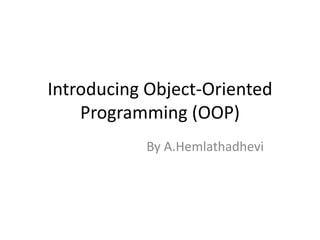

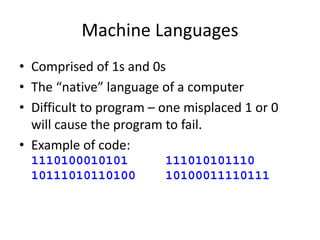
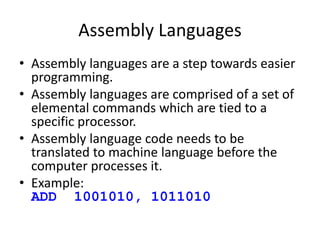



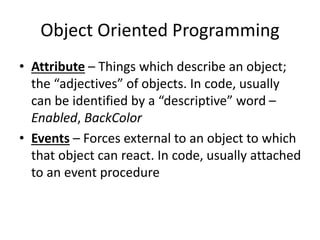



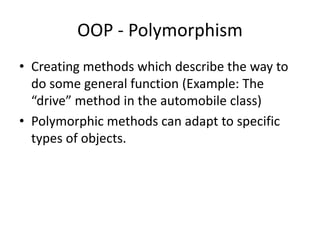



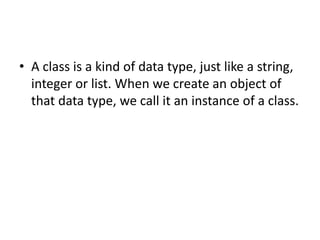
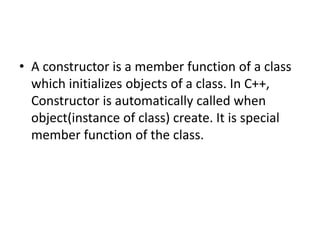







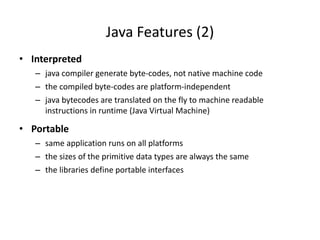



Ad
Recommended
Java



JavaZeeshan Khan Java is a widely used programming language that was created in 1991. It is an object-oriented language that is platform independent and runs on a virtual machine. Key features of Java include being simple, object-oriented, robust, secure, and portable. The Java runtime environment includes the Java virtual machine which executes Java bytecode. Common uses of Java include developing desktop and web applications, mobile apps, and embedded systems.
Java Tokens



Java TokensMadishetty Prathibha In this you will learn about Java Tokens
1. Keywords
2. Identifiers
3. Constants
4. Operators
5. Separators
- Comments in Java and types of comments
Presentation on java



Presentation on javashashi shekhar The document provides an overview of core Java concepts including:
- Java is an object-oriented programming language and platform that runs on a virtual machine. It is used to create desktop, web, enterprise, mobile and other applications.
- Core Java concepts include objects, classes, inheritance, polymorphism, abstraction and encapsulation. The document also discusses variables and data types, OOP principles, object creation, method overloading and constructors.
- It provides examples of Hello World programs and explains Java memory areas like stack and heap. Key topics like static keyword, method vs constructor and method overloading are also summarized.
Introduction to Object-Oriented Concepts and Java 



Introduction to Object-Oriented Concepts and Java Dr. Rosemarie Sibbaluca-Guirre Class is a blueprint that represents common objects and contains their shared elements. An object is an instance of a class that has a specific state and behavior. Java supports object-oriented programming concepts like encapsulation, inheritance, and polymorphism. It is a popular language that is hardware independent, allowing programs to run on different platforms.
Building reactive systems with Akka



Building reactive systems with AkkaKristof Jozsa A short intro to reactive systems, Scala, Akka and the Play Framework, with a Twitter based live demonstration and performance meters. Find the sample code at https://github.com/kjozsa/reactive2
13243967



13243967vijayabharati This document discusses object serialization in Java. Serialization is the process of converting an object's state into a byte stream to store or transmit the object. Deserialization reconstructs the object from the byte stream. The Student class implements the Serializable interface, allowing its objects to be serialized. ObjectOutputStream writes objects to an output stream, while ObjectInputStream deserializes objects from an input stream and reconstructs the object. An example demonstrates serializing a Student object to a file and then deserializing and printing its attributes.
[OOP - Lec 01] Introduction to OOP![[OOP - Lec 01] Introduction to OOP](https://cdn.slidesharecdn.com/ss_thumbnails/lecture-01introductiontooop-160604052612-thumbnail.jpg?width=560&fit=bounds)
![[OOP - Lec 01] Introduction to OOP](https://cdn.slidesharecdn.com/ss_thumbnails/lecture-01introductiontooop-160604052612-thumbnail.jpg?width=560&fit=bounds)
![[OOP - Lec 01] Introduction to OOP](https://cdn.slidesharecdn.com/ss_thumbnails/lecture-01introductiontooop-160604052612-thumbnail.jpg?width=560&fit=bounds)
![[OOP - Lec 01] Introduction to OOP](https://cdn.slidesharecdn.com/ss_thumbnails/lecture-01introductiontooop-160604052612-thumbnail.jpg?width=560&fit=bounds)
[OOP - Lec 01] Introduction to OOPMuhammad Hammad Waseem This document outlines an object-oriented programming course. The course aims to teach OOP concepts like encapsulation, inheritance and polymorphism using C++. It will cover basic building blocks like classes and objects, access specifiers, constructors, destructors, function overloading and more. Students are expected to have experience in C and knowledge of functions, structures and pointers. The goal is to learn OOP principles, practice coding, and ask questions.
Python's dynamic nature (rough slides, November 2004)



Python's dynamic nature (rough slides, November 2004)Kiran Jonnalagadda Draft slides for a presentation at Linux Bangalore/2004 (FOSS.IN from 2005) on Python, made in November 2004.
Java Tutorial Lab 1



Java Tutorial Lab 1Berk Soysal Introduction to Java, its syntax and environment setup
The first tutorial is going to be an introduction to Java and its syntax. The tutorial starts with basic examples such as printing out a String and ends with some quiz questions for you to practice what you have learned. Also I provided the download links for the Integrated Development Environments for Java Programming. The rest of the tutorials will follow the same content-quiz pattern so get ready for some hands on experience!
Check out rest of the Tutorials: https://berksoysal.blogspot.com/2016/06/java-se-tutorials-basics-exercises.html
Comp102 lec 3



Comp102 lec 3Fraz Bakhsh Java is an object-oriented programming language developed by James Gosling at Sun Microsystems in 1991. It derives much of its syntax from C and C++ but is designed to have as few implementation dependencies as possible so that applications written in Java can run on any device with a Java Virtual Machine (JVM). The JVM converts Java bytecode into machine code that can be executed by the device's processor. This allows Java programs to run on any platform that has a JVM without needing to be recompiled.
CS8392 OOP



CS8392 OOPDhanalakshmiVelusamy1 This document provides an overview of object-oriented programming concepts in Java including abstraction, encapsulation, inheritance, and polymorphism. It discusses key Java concepts like classes, objects, methods, and access specifiers. It also covers Java fundamentals like variables, data types, operators, control flow statements, comments, and arrays. Additionally, it describes the Java runtime environment, how to set up a Java development environment, compile and run a simple Java program. The document is intended as an introduction to object-oriented programming and the Java programming language.
Short notes of oop with java



Short notes of oop with javaMohamed Fathy This document provides an introduction to object oriented programming concepts in Java. It discusses key topics like what a computer is, developer skills, memory management, and an introduction to Java. Object oriented programming principles like inheritance, abstraction, encapsulation, and polymorphism are defined. The document also covers exceptions in Java like defining exceptions, reasons they occur, and handling exceptions.
java training in jaipur|java training|core java training|java training compa...



java training in jaipur|java training|core java training|java training compa...infojaipurinfo Jaipur
http://www.mcainternship.online/core-java/
java training in jaipur|java training|core java training|java training company in jaipur|java training company|java training institute
#javatraininginjaipur
#javatraining
#corejavatraining|
#javatrainingcompanyinjaipur
#javatrainingcompany
#javatraininginstitute
Classes objects in java



Classes objects in javaMadishetty Prathibha The document discusses key concepts in Java including classes, objects, methods, and command line arguments. A class defines common properties and behaviors for objects through fields and methods. Objects are instantiated from classes and can access fields and methods using dot notation. Command line arguments allow passing data into a Java application and are accessed through the args parameter in the main method.
[OOP - Lec 04,05] Basic Building Blocks of OOP![[OOP - Lec 04,05] Basic Building Blocks of OOP](https://cdn.slidesharecdn.com/ss_thumbnails/lecture-0405basicbuildingblocksofoop-160604055658-thumbnail.jpg?width=560&fit=bounds)
![[OOP - Lec 04,05] Basic Building Blocks of OOP](https://cdn.slidesharecdn.com/ss_thumbnails/lecture-0405basicbuildingblocksofoop-160604055658-thumbnail.jpg?width=560&fit=bounds)
![[OOP - Lec 04,05] Basic Building Blocks of OOP](https://cdn.slidesharecdn.com/ss_thumbnails/lecture-0405basicbuildingblocksofoop-160604055658-thumbnail.jpg?width=560&fit=bounds)
![[OOP - Lec 04,05] Basic Building Blocks of OOP](https://cdn.slidesharecdn.com/ss_thumbnails/lecture-0405basicbuildingblocksofoop-160604055658-thumbnail.jpg?width=560&fit=bounds)
[OOP - Lec 04,05] Basic Building Blocks of OOPMuhammad Hammad Waseem Objects represent real-world entities and have unique identities, states, and behaviors. A class defines the structure and behavior of objects through instance variables and methods. Objects are created from classes and inherit their structure and functionality. Key concepts in object-oriented programming include encapsulation, polymorphism, inheritance, abstract classes, and static and dynamic binding.
Java Programming Fundamentals 



Java Programming Fundamentals Dr. Rosemarie Sibbaluca-Guirre Java Programming Fundamentals
Classes and Methods
Syntax and RunTime Errors
Java Program Statements
Java Blocks
Java Comments
Lambdas



Lambdasmalliksunkara This document discusses Java 8 features including defining methods in interfaces, functional programming concepts, lambda expressions, and the stream API. Key points include: interfaces can now define default and static methods; functional programming uses declarative code, avoids mutability, and handles concurrency; lambda expressions define anonymous methods; and the stream API processes data in parallel streams to leverage multi-core architectures.
C Sharp Course 101.5



C Sharp Course 101.5Shahed Chowdhuri Updated version of C# Crash Course for college students and any beginner who wants to learn the popular language. (Beginner - Intermediate)
Scala, Play 2.0 & Cloud Foundry



Scala, Play 2.0 & Cloud FoundryPray Desai Scala is a programming language that combines object-oriented and functional programming. It runs on the Java Virtual Machine and is designed to grow with user demands through libraries. Play 2.0 is a web application framework written in Scala that allows for rapid development through its Model-View-Controller architecture and local development server. Cloud Foundry is an open Platform as a Service that allows developers to easily deploy and scale applications, including those written in Scala and Play 2.0.
Java & advanced java



Java & advanced javaBASAVARAJ HUNSHAL The document provides an introduction to Java programming concepts including object-oriented programming, Java features, program structure, tokens, control statements, arrays, classes and objects. It discusses key Java concepts such as encapsulation, inheritance and polymorphism. The document also compares Java to C++ and covers data types, operators, selection statements, iteration statements and type conversion in Java.
Swing api



Swing apiRavi_Kant_Sahu This document provides an introduction to GUI programming using Swing in Java. It discusses the key differences between AWT and Swing, including that Swing components are lightweight and platform independent. The document covers Swing concepts like the model-view-controller architecture, event dispatch thread, common Swing components like JPanel and JScrollPane, and layout managers. It also discusses setting colors, fonts, and default operations in a JFrame. The goal of the document is to introduce developers to essential Swing concepts for GUI programming in Java.
Introduction to Java



Introduction to JavaAnkita Totala 1) Java is an object-oriented programming language that uses a Java Virtual Machine (JVM) to run programs on different platforms like Linux and Windows.
2) The Java APIs provide prebuilt classes that can be used in programs to simplify development.
3) Key features of Java include being simple, architecture-neutral, object-oriented, distributed, compiled, interpreted, statically typed, multi-threaded, garbage collected, portable, high-performance, robust, secure, and extensible.
Basic OOPS concept for Core JAVA



Basic OOPS concept for Core JAVAAnkita Totala This document discusses object-oriented programming concepts. It defines an object as anything that can be represented by data and manipulated by a program. An object contains both data, representing its state, and methods that manipulate the data. The four main pillars of OOP are encapsulation, abstraction, polymorphism, and inheritance. Encapsulation bundles data and code into single units, while abstraction hides implementation details. Polymorphism allows the same method to act differently based on the object, and inheritance allows a class to acquire properties from another class.
Buffer and scanner



Buffer and scannerArif Ullah The document discusses input and output streams in Java. It describes the BufferedReader class, which reads text from a character input stream and buffers it for efficient reading. It also discusses the Scanner class in Java's util package for reading user input through the keyboard. An example program is provided that uses Scanner to read integer and float values from the user and calculate their sum.
Oopsinphp



OopsinphpNithyaNithyav defination for object oriented programming,concept for oops,defination for class,object,member variable,member function,inheritance,parentclass and child class defination,polymorphism,overloading,dataabstraction,encapsulation,constructor and destructor,interfaces and rules,abstract class,object cloning
Introduction to Scala



Introduction to ScalaRahul Jain A Short presentation on Scala for beginners with Introduction to Functional Programming, Basics of Scala, Use-casses and Examples
C sharp



C sharpSatish Verma This document provides an overview of programming with C# and .NET. It discusses key concepts like the .NET Framework, Common Language Runtime (CLR), C# language features, assemblies, namespaces, properties, delegates and events, inheritance, interfaces, structures, pointers, boxing and unboxing, ref and out parameters, and .NET Remoting. It includes examples to demonstrate many of these programming concepts.
Computer Science ACW Intro to OOP L7.pptx



Computer Science ACW Intro to OOP L7.pptxEdmondLabule2 Introduction to Computer Science Object Oriented Programming for ESL first year university students.
General oop concept



General oop conceptAvneesh Yadav This document discusses object-oriented programming (OOP) concepts and languages. It begins with an introduction to programming languages from low-level machine languages to high-level languages. It then covers OOP concepts like classes, objects, encapsulation, inheritance, and polymorphism. It provides examples to illustrate these concepts. The document also discusses advantages and disadvantages of OOP as well as its suitability for complex, modular systems that can benefit from code reuse.
More Related Content
What's hot (19)
Java Tutorial Lab 1



Java Tutorial Lab 1Berk Soysal Introduction to Java, its syntax and environment setup
The first tutorial is going to be an introduction to Java and its syntax. The tutorial starts with basic examples such as printing out a String and ends with some quiz questions for you to practice what you have learned. Also I provided the download links for the Integrated Development Environments for Java Programming. The rest of the tutorials will follow the same content-quiz pattern so get ready for some hands on experience!
Check out rest of the Tutorials: https://berksoysal.blogspot.com/2016/06/java-se-tutorials-basics-exercises.html
Comp102 lec 3



Comp102 lec 3Fraz Bakhsh Java is an object-oriented programming language developed by James Gosling at Sun Microsystems in 1991. It derives much of its syntax from C and C++ but is designed to have as few implementation dependencies as possible so that applications written in Java can run on any device with a Java Virtual Machine (JVM). The JVM converts Java bytecode into machine code that can be executed by the device's processor. This allows Java programs to run on any platform that has a JVM without needing to be recompiled.
CS8392 OOP



CS8392 OOPDhanalakshmiVelusamy1 This document provides an overview of object-oriented programming concepts in Java including abstraction, encapsulation, inheritance, and polymorphism. It discusses key Java concepts like classes, objects, methods, and access specifiers. It also covers Java fundamentals like variables, data types, operators, control flow statements, comments, and arrays. Additionally, it describes the Java runtime environment, how to set up a Java development environment, compile and run a simple Java program. The document is intended as an introduction to object-oriented programming and the Java programming language.
Short notes of oop with java



Short notes of oop with javaMohamed Fathy This document provides an introduction to object oriented programming concepts in Java. It discusses key topics like what a computer is, developer skills, memory management, and an introduction to Java. Object oriented programming principles like inheritance, abstraction, encapsulation, and polymorphism are defined. The document also covers exceptions in Java like defining exceptions, reasons they occur, and handling exceptions.
java training in jaipur|java training|core java training|java training compa...



java training in jaipur|java training|core java training|java training compa...infojaipurinfo Jaipur
http://www.mcainternship.online/core-java/
java training in jaipur|java training|core java training|java training company in jaipur|java training company|java training institute
#javatraininginjaipur
#javatraining
#corejavatraining|
#javatrainingcompanyinjaipur
#javatrainingcompany
#javatraininginstitute
Classes objects in java



Classes objects in javaMadishetty Prathibha The document discusses key concepts in Java including classes, objects, methods, and command line arguments. A class defines common properties and behaviors for objects through fields and methods. Objects are instantiated from classes and can access fields and methods using dot notation. Command line arguments allow passing data into a Java application and are accessed through the args parameter in the main method.
[OOP - Lec 04,05] Basic Building Blocks of OOP![[OOP - Lec 04,05] Basic Building Blocks of OOP](https://cdn.slidesharecdn.com/ss_thumbnails/lecture-0405basicbuildingblocksofoop-160604055658-thumbnail.jpg?width=560&fit=bounds)
![[OOP - Lec 04,05] Basic Building Blocks of OOP](https://cdn.slidesharecdn.com/ss_thumbnails/lecture-0405basicbuildingblocksofoop-160604055658-thumbnail.jpg?width=560&fit=bounds)
![[OOP - Lec 04,05] Basic Building Blocks of OOP](https://cdn.slidesharecdn.com/ss_thumbnails/lecture-0405basicbuildingblocksofoop-160604055658-thumbnail.jpg?width=560&fit=bounds)
![[OOP - Lec 04,05] Basic Building Blocks of OOP](https://cdn.slidesharecdn.com/ss_thumbnails/lecture-0405basicbuildingblocksofoop-160604055658-thumbnail.jpg?width=560&fit=bounds)
[OOP - Lec 04,05] Basic Building Blocks of OOPMuhammad Hammad Waseem Objects represent real-world entities and have unique identities, states, and behaviors. A class defines the structure and behavior of objects through instance variables and methods. Objects are created from classes and inherit their structure and functionality. Key concepts in object-oriented programming include encapsulation, polymorphism, inheritance, abstract classes, and static and dynamic binding.
Java Programming Fundamentals 



Java Programming Fundamentals Dr. Rosemarie Sibbaluca-Guirre Java Programming Fundamentals
Classes and Methods
Syntax and RunTime Errors
Java Program Statements
Java Blocks
Java Comments
Lambdas



Lambdasmalliksunkara This document discusses Java 8 features including defining methods in interfaces, functional programming concepts, lambda expressions, and the stream API. Key points include: interfaces can now define default and static methods; functional programming uses declarative code, avoids mutability, and handles concurrency; lambda expressions define anonymous methods; and the stream API processes data in parallel streams to leverage multi-core architectures.
C Sharp Course 101.5



C Sharp Course 101.5Shahed Chowdhuri Updated version of C# Crash Course for college students and any beginner who wants to learn the popular language. (Beginner - Intermediate)
Scala, Play 2.0 & Cloud Foundry



Scala, Play 2.0 & Cloud FoundryPray Desai Scala is a programming language that combines object-oriented and functional programming. It runs on the Java Virtual Machine and is designed to grow with user demands through libraries. Play 2.0 is a web application framework written in Scala that allows for rapid development through its Model-View-Controller architecture and local development server. Cloud Foundry is an open Platform as a Service that allows developers to easily deploy and scale applications, including those written in Scala and Play 2.0.
Java & advanced java



Java & advanced javaBASAVARAJ HUNSHAL The document provides an introduction to Java programming concepts including object-oriented programming, Java features, program structure, tokens, control statements, arrays, classes and objects. It discusses key Java concepts such as encapsulation, inheritance and polymorphism. The document also compares Java to C++ and covers data types, operators, selection statements, iteration statements and type conversion in Java.
Swing api



Swing apiRavi_Kant_Sahu This document provides an introduction to GUI programming using Swing in Java. It discusses the key differences between AWT and Swing, including that Swing components are lightweight and platform independent. The document covers Swing concepts like the model-view-controller architecture, event dispatch thread, common Swing components like JPanel and JScrollPane, and layout managers. It also discusses setting colors, fonts, and default operations in a JFrame. The goal of the document is to introduce developers to essential Swing concepts for GUI programming in Java.
Introduction to Java



Introduction to JavaAnkita Totala 1) Java is an object-oriented programming language that uses a Java Virtual Machine (JVM) to run programs on different platforms like Linux and Windows.
2) The Java APIs provide prebuilt classes that can be used in programs to simplify development.
3) Key features of Java include being simple, architecture-neutral, object-oriented, distributed, compiled, interpreted, statically typed, multi-threaded, garbage collected, portable, high-performance, robust, secure, and extensible.
Basic OOPS concept for Core JAVA



Basic OOPS concept for Core JAVAAnkita Totala This document discusses object-oriented programming concepts. It defines an object as anything that can be represented by data and manipulated by a program. An object contains both data, representing its state, and methods that manipulate the data. The four main pillars of OOP are encapsulation, abstraction, polymorphism, and inheritance. Encapsulation bundles data and code into single units, while abstraction hides implementation details. Polymorphism allows the same method to act differently based on the object, and inheritance allows a class to acquire properties from another class.
Buffer and scanner



Buffer and scannerArif Ullah The document discusses input and output streams in Java. It describes the BufferedReader class, which reads text from a character input stream and buffers it for efficient reading. It also discusses the Scanner class in Java's util package for reading user input through the keyboard. An example program is provided that uses Scanner to read integer and float values from the user and calculate their sum.
Oopsinphp



OopsinphpNithyaNithyav defination for object oriented programming,concept for oops,defination for class,object,member variable,member function,inheritance,parentclass and child class defination,polymorphism,overloading,dataabstraction,encapsulation,constructor and destructor,interfaces and rules,abstract class,object cloning
Introduction to Scala



Introduction to ScalaRahul Jain A Short presentation on Scala for beginners with Introduction to Functional Programming, Basics of Scala, Use-casses and Examples
C sharp



C sharpSatish Verma This document provides an overview of programming with C# and .NET. It discusses key concepts like the .NET Framework, Common Language Runtime (CLR), C# language features, assemblies, namespaces, properties, delegates and events, inheritance, interfaces, structures, pointers, boxing and unboxing, ref and out parameters, and .NET Remoting. It includes examples to demonstrate many of these programming concepts.
java training in jaipur|java training|core java training|java training compa...



java training in jaipur|java training|core java training|java training compa...infojaipurinfo Jaipur
Similar to Introducing object oriented programming (oop) (20)
Computer Science ACW Intro to OOP L7.pptx



Computer Science ACW Intro to OOP L7.pptxEdmondLabule2 Introduction to Computer Science Object Oriented Programming for ESL first year university students.
General oop concept



General oop conceptAvneesh Yadav This document discusses object-oriented programming (OOP) concepts and languages. It begins with an introduction to programming languages from low-level machine languages to high-level languages. It then covers OOP concepts like classes, objects, encapsulation, inheritance, and polymorphism. It provides examples to illustrate these concepts. The document also discusses advantages and disadvantages of OOP as well as its suitability for complex, modular systems that can benefit from code reuse.
Letest



LetestPrakash Poudel Java is an object-oriented programming language that is platform independent. It was developed by Sun Microsystems, now owned by Oracle. Java code is compiled into bytecode that runs on a Java Virtual Machine (JVM), allowing it to run on any device with a JVM. Java supports features like inheritance, polymorphism, and encapsulation. It is widely used for client-side applications like applets and server-side applications like servlets and Java Server Pages (JSP). The main Java editions are Java SE for desktop applications, Java EE for enterprise applications, and Java ME for mobile applications.
Java Programming concept 



Java Programming concept Prakash Poudel Java is an object-oriented programming language that is platform independent. It was developed by Sun Microsystems, now owned by Oracle. Java code is compiled into bytecode that runs on a Java Virtual Machine (JVM), allowing it to run on any device that supports a JVM. Java supports features like inheritance, polymorphism, and encapsulation. It is widely used for client-side applications like applets and server-side applications like servlets and Java Server Pages (JSP). The main Java editions are Java SE for desktop applications, Java EE for enterprise applications, and Java ME for mobile applications.
Object Oriented Programming All Unit Notes



Object Oriented Programming All Unit NotesBalamuruganV28 The document provides an overview of object-oriented programming (OOP) and the Java programming language. It defines key OOP concepts like objects, classes, encapsulation, inheritance, and polymorphism. It also describes features of Java like platform independence, simplicity, security, and robustness. The document then explains basic Java concepts like data types, variables, arrays, control structures, and defining classes, constructors, and methods. It provides examples of operators in Java and the difference between procedural and object-oriented programming.
M.c.a. (sem iv)- java programming



M.c.a. (sem iv)- java programmingPraveen Chowdary This document provides a syllabus for a Java Programming course. The course consists of 7 topics that will be covered through lectures and practical sessions over several weeks. Students will have one exam worth 100 marks and a practical exam worth 50 marks. They will also complete term work assignments worth 25 marks. The topics covered include Java fundamentals, classes, exception handling, IO packages, multi-threading, GUI, and database connectivity. Students will submit programming assignments related to these topics as part of their term work. References for the course are also provided.
Introduction to Object Oriented Programming



Introduction to Object Oriented ProgrammingMoutaz Haddara An Introduction to Object-Oriented Programming (OOP)
Download the presentation to view it correctly, as it has some animations that won't show here.
If you have any questions, please contact me. You are free to use it this presentation, but it would be nice at least to give me some credit :)
Content:
1- History of Programming
2. Objects and Classes
3- Abstraction, Inheritance, Encapsulation, and Polymorphism
MCA NOTES.pdf



MCA NOTES.pdfRAJASEKHARV10 This document provides a syllabus for a Java programming course including:
- 7 topics that will be covered ranging from Java fundamentals to database connectivity.
- A practical exam worth 50 marks involving 10 programming assignments.
- 12 programming assignments that will be completed as part of the term work.
- 4 references books that will be used for the course.
4-OOPS.pptx



4-OOPS.pptxSatyamMishra237306 This document provides an overview of object-oriented programming concepts including classes, objects, encapsulation, inheritance, and polymorphism. It defines key terms like class, object, field, and method. It gives examples of how classes can model real-world entities like a circle or employee. The document explains that classes form a hierarchy where subclasses inherit fields and methods from parent classes. Encapsulation and information hiding are achieved by grouping data and methods into classes. Polymorphism allows different processing of objects depending on their class.
java oops and java very important for .pptx



java oops and java very important for .pptxcherukuriyuvaraju9 ava oops and java very important for .pptx
java oops compilation object class inheritance.pptx



java oops compilation object class inheritance.pptxCHERUKURIYUVARAJU209 java oops compilation object class inheritance
Programming using C++ - slides.pptx



Programming using C++ - slides.pptxHeadoftheDepartment This document discusses object oriented programming using C++. It begins by covering topics like principles of OOP, the need for studying the subject, and how C++ overcomes the software crisis. It then discusses the software crisis in more detail, including characteristics of problematic software. The evolution of programming languages from machine code to assembly to high-level languages is examined. Finally, the document introduces C++ and how it facilitates object oriented programming to address issues with procedural programming.
1 Introduction to JAVA.pptx



1 Introduction to JAVA.pptxKabiles07 This document provides an introduction to Java and Object-Oriented Programming (OOP) concepts. It defines key OOPs concepts like objects, classes, abstraction, encapsulation, inheritance, and polymorphism. It also discusses the features of Java like being simple, object-oriented, platform independent, secure, robust, portable, and high-performance. The document then provides examples of where Java is used including desktop applications, web applications, enterprise applications, mobile applications, and more.
The smartpath information systems c plus plus



The smartpath information systems c plus plusThe Smartpath Information Systems,Bhilai,Durg,Chhattisgarh. C++ is an object-oriented programming language developed by Bjarne Stroustrup at AT&T Bell Lab in the year 1980. Initially it was named “C with classes” but later in 1983 the name changed to C++. It is an extension of C with..
object oriented programming in c++ introduction lecture 1.pptx



object oriented programming in c++ introduction lecture 1.pptxamna hussain LECTURE NOTES OF OBJECT ORIENTED PROGRAMMING LANGUAGES IN C++
The smartpath information systems c plus plus



The smartpath information systems c plus plusThe Smartpath Information Systems,Bhilai,Durg,Chhattisgarh.
Ad
Recently uploaded (20)
May 2025: Top 10 Read Articles Advanced Information Technology



May 2025: Top 10 Read Articles Advanced Information Technologyijait International journal of advanced Information technology (IJAIT) is a bi monthly open access peer-reviewed journal, will act as a major forum for the presentation of innovative ideas, approaches, developments, and research projects in the area advanced information technology applications and services. It will also serve to facilitate the exchange of information between researchers and industry professionals to discuss the latest issues and advancement in the area of advanced IT. Core areas of advanced IT and multi-disciplinary and its applications will be covered during the conferences.
02 - Ethics & Professionalism - BEM, IEM, MySET.PPT



02 - Ethics & Professionalism - BEM, IEM, MySET.PPTSharinAbGhani1 ethics & professionalism based on BEM
Airport_Substation_With_Diagrams (2).pptx



Airport_Substation_With_Diagrams (2).pptxBibekMedhi2 A substation at an airport is a vital infrastructure component that ensures reliable and efficient power distribution for all airport operations. It acts as a crucial link, converting high-voltage electricity from the main grid to the lower voltages needed for various airport facilities. This essay will explore the functions, components, and importance of a substation at an airport.
Functions of an Airport Substation:
Voltage Conversion:
Substations step down high-voltage electricity to lower levels suitable for airport operations, like terminal buildings, runways, and other facilities.
Power Distribution:
They distribute electricity to various loads, including lighting, air conditioning, navigation systems, and ground support equipment.
Grid Stability:
Substations help maintain the stability of the power grid by controlling voltage levels and managing power flows.
Redundancy and Reliability:
Airports often have redundant substations or interconnected systems to ensure uninterrupted power supply, even in case of a fault.
Switching and Control:
Substations provide switching capabilities to connect or disconnect circuits, enabling maintenance and power management.
Protection:
Substations incorporate protective devices, like circuit breakers and relays, to safeguard the power system from faults and ensure safe operation.
Key Components of an Airport Substation:
Transformers: These convert high-voltage electricity to lower voltage levels.
Circuit Breakers: These devices switch circuits on or off, protecting the system from faults.
Busbars: These are large, conductive bars that distribute electricity from transformers to other equipment.
Switchgear: This includes equipment that controls the flow of electricity, such as isolators and switches.
Control and Protection Systems: These systems monitor the substation's performance, detect faults, and automatically initiate corrective actions.
Capacitors: These improve the power factor and reduce losses in the system.
Importance of Airport Substations:
Reliable Power Supply:
Substations are essential for providing reliable power to critical airport functions, ensuring safety and efficiency.
Safe and Efficient Operations:
They contribute to the safe and efficient operation of runways, terminals, and other airport facilities.
Airport Infrastructure:
Substations are an integral part of the airport's infrastructure, enabling various operations and services.
Economic Impact:
Substations support the economic activities of the airport, including passenger and cargo handling.
Modernization and Sustainability:
Modern substations incorporate advanced technologies and systems to improve efficiency, reduce energy consumption, and enhance sustainability.
In conclusion, an airport substation is a crucial component of airport infrastructure, ensuring reliable and efficient power distribution, grid stability, and safe operations.
22PCOAM16 _ML_Unit 3 Notes & Question bank



22PCOAM16 _ML_Unit 3 Notes & Question bankGuru Nanak Technical Institutions 22PCOAM16 _ML_Unit 3 Notes & Question bank
A DECISION SUPPORT SYSTEM FOR ESTIMATING COST OF SOFTWARE PROJECTS USING A HY...



A DECISION SUPPORT SYSTEM FOR ESTIMATING COST OF SOFTWARE PROJECTS USING A HY...ijfcstjournal One of the major challenges for software, nowadays, is software cost estimation. It refers to estimating the
cost of all activities including software development, design, supervision, maintenance and so on. Accurate
cost-estimation of software projects optimizes the internal and external processes, staff works, efforts and
the overheads to be coordinated with one another. In the management software projects, estimation must
be taken into account so that reduces costs, timing and possible risks to avoid project failure. In this paper,
a decision- support system using a combination of multi-layer artificial neural network and decision tree is
proposed to estimate the cost of software projects. In the model included into the proposed system,
normalizing factors, which is vital in evaluating efforts and costs estimation, is carried out using C4.5
decision tree. Moreover, testing and training factors are done by multi-layer artificial neural network and
the most optimal values are allocated to them. The experimental results and evaluations on Dataset
NASA60 show that the proposed system has less amount of the total average relative error compared with
COCOMO model.
社内勉強会資料_Chain of Thought .



社内勉強会資料_Chain of Thought .NABLAS株式会社 本資料「To CoT or not to CoT?」では、大規模言語モデルにおけるChain of Thought(CoT)プロンプトの効果について詳しく解説しています。
CoTはあらゆるタスクに効く万能な手法ではなく、特に数学的・論理的・アルゴリズム的な推論を伴う課題で高い効果を発揮することが実験から示されています。
一方で、常識や一般知識を問う問題に対しては効果が限定的であることも明らかになりました。
複雑な問題を段階的に分解・実行する「計画と実行」のプロセスにおいて、CoTの強みが活かされる点も注目ポイントです。
This presentation explores when Chain of Thought (CoT) prompting is truly effective in large language models.
The findings show that CoT significantly improves performance on tasks involving mathematical or logical reasoning, while its impact is limited on general knowledge or commonsense tasks.
Semi-Conductor ppt ShubhamSeSemi-Con.pptx



Semi-Conductor ppt ShubhamSeSemi-Con.pptxstudyshubham18 semi conductor basics; types of semi conductor and its properties
A Comprehensive Investigation into the Accuracy of Soft Computing Tools for D...



A Comprehensive Investigation into the Accuracy of Soft Computing Tools for D...Journal of Soft Computing in Civil Engineering This study will provide the audience with an understanding of the capabilities of soft tools such as Artificial Neural Networks (ANN), Support Vector Regression (SVR), Model Trees (MT), and Multi-Gene Genetic Programming (MGGP) as a statistical downscaling tool. Many projects are underway around the world to downscale the data from Global Climate Models (GCM). The majority of the statistical tools have a lengthy downscaling pipeline to follow. To improve its accuracy, the GCM data is re-gridded according to the grid points of the observed data, standardized, and, sometimes, bias-removal is required. The current work suggests that future precipitation can be predicted by using precipitation data from the nearest four grid points as input to soft tools and observed precipitation as output. This research aims to estimate precipitation trends in the near future (2021-2050), using 5 GCMs, for Pune, in the state of Maharashtra, India. The findings indicate that each one of the soft tools can model the precipitation with excellent accuracy as compared to the traditional method of Distribution Based Scaling (DBS). The results show that ANN models appear to give the best results, followed by MT, then MGGP, and finally SVR. This work is one of a kind in that it provides insights into the changing monsoon season in Pune. The anticipated average precipitation levels depict a rise of 300–500% in January, along with increases of 200-300% in February and March, and a 100-150% increase for April and December. In contrast, rainfall appears to be decreasing by 20-30% between June and September.
IntroSlides-June-GDG-Cloud-Munich community [email protected]



IntroSlides-June-GDG-Cloud-Munich community [email protected]Luiz Carneiro Introduction slides for starting the June GDG Cloud Munich community gathering in Munich, Germany.
Irja Straus - Beyond Pass and Fail - DevTalks.pdf



Irja Straus - Beyond Pass and Fail - DevTalks.pdfIrja Straus Slides from DevTalks where I gave a keynote about metrics.
How Binning Affects LED Performance & Consistency.pdf



How Binning Affects LED Performance & Consistency.pdfMina Anis 🔍 What’s Inside:
📦 What Is LED Binning?
• The process of sorting LEDs by color temperature, brightness, voltage, and CRI
• Ensures visual and performance consistency across large installations
🎨 Why It Matters:
• Inconsistent binning leads to uneven color and brightness
• Impacts brand perception, customer satisfaction, and warranty claims
📊 Key Concepts Explained:
• SDCM (Standard Deviation of Color Matching)
• Recommended bin tolerances by application (e.g., 1–3 SDCM for retail/museums)
• How to read bin codes from LED datasheets
• The difference between ANSI/NEMA standards and proprietary bin maps
🧠 Advanced Practices:
• AI-assisted bin prediction
• Color blending and dynamic calibration
• Customized binning for high-end or global projects
Strength of materials (Thermal stress and strain relationships)



Strength of materials (Thermal stress and strain relationships)pelumiadigun2006 Understand thermal stress and strain relationships in normal objects and composite bodies
A Comprehensive Investigation into the Accuracy of Soft Computing Tools for D...



A Comprehensive Investigation into the Accuracy of Soft Computing Tools for D...Journal of Soft Computing in Civil Engineering
Ad
Introducing object oriented programming (oop)
- 1. Introducing Object-Oriented Programming (OOP) By A.Hemlathadhevi
- 2. Programming Languages • Programming languages allow programmers to code software. • The three major families of languages are: – Machine languages – Assembly languages – High-Level languages
- 3. Machine Languages • Comprised of 1s and 0s • The “native” language of a computer • Difficult to program – one misplaced 1 or 0 will cause the program to fail. • Example of code: 1110100010101 111010101110 10111010110100 10100011110111
- 4. Assembly Languages • Assembly languages are a step towards easier programming. • Assembly languages are comprised of a set of elemental commands which are tied to a specific processor. • Assembly language code needs to be translated to machine language before the computer processes it. • Example: ADD 1001010, 1011010
- 5. High-Level Languages • High-level languages represent a giant leap towards easier programming. • The syntax of HL languages is similar to English. • Historically, we divide HL languages into two groups: – Procedural languages – Object-Oriented languages (OOP)
- 6. Procedural Languages • Early high-level languages are typically called procedural languages. • Procedural languages are characterized by sequential sets of linear commands. The focus of such languages is on structure. • Examples include C, COBOL, Fortran, LISP, Perl, HTML, VBScript
- 7. Object Oriented Programming • Object – Unique programming entity that has methods, has attributes and can react to events. • Method – Things which an object can do; the “verbs” of objects. In code, usually can be identified by an “action” word -- Hide, Show
- 8. Object Oriented Programming • Attribute – Things which describe an object; the “adjectives” of objects. In code, usually can be identified by a “descriptive” word – Enabled, BackColor • Events – Forces external to an object to which that object can react. In code, usually attached to an event procedure
- 9. Object Oriented Programming • Class – Provides a way to create new objects based on a “meta-definition” of an object (Example: The automobile class) • Constructors – Special methods used to create new instances of a class (Example: A Honda Civic is an instance of the automobile class.)
- 10. OOP - Encapsulation • Incorporation into a class of data & operations in one package • Data can only be accessed through that package • “Information Hiding”
- 11. OOP - Inheritance • Allows programmers to create new classes based on an existing class • Methods and attributes from the parent class are inherited by the newly-created class • New methods and attributes can be created in the new class, but don’t affect the parent class’s definition
- 12. OOP - Polymorphism • Creating methods which describe the way to do some general function (Example: The “drive” method in the automobile class) • Polymorphic methods can adapt to specific types of objects.
- 13. Classes and Objects • A class is a data type that allows programmers to create objects. A class provides a definition for an object, describing an object’s attributes (data) and methods (operations). • An object is an instance of a class. With one class, you can have as many objects as required. • This is analogous to a variable and a data type, the class is the data type and the object is the variable.
- 14. Thank you
- 15. • Mam, I learnt that, object is a instance of class, and constructor is also a instance of a class. How can it be possible mam?. Can you please explain mam? But the declaration of a object is different from constructor.(learnt from c++) Please explain mam
- 16. • A class is a kind of data type, just like a string, integer or list. When we create an object of that data type, we call it an instance of a class.
- 17. • A constructor is a member function of a class which initializes objects of a class. In C++, Constructor is automatically called when object(instance of class) create. It is special member function of the class.
- 18. • How constructors are different from a normal member function? A constructor is different from normal functions in following ways: Constructor has same name as the class itself Constructors don’t have return type A constructor is automatically called when an object is created.
- 19. If we do not specify a constructor, C++ compiler generates a default constructor for us (expects no parameters and has an empty body).
- 20. • we have created a simple object and then we assign values to each data member of the class in the main function after reading these values from the standard input. Then ,we will take a look at a special function that is used to initialize the object during its creation. This special function is called a constructor.
- 21. because the constructor is a special member function of class.
- 22. • 3 classs
- 23. What is java? • Developed by Sun Microsystems (James Gosling) • A general-purpose object-oriented language • Based on C/C++ • Designed for easy Web/Internet applications • Widespread acceptance
- 24. Java Features (1) • Simple – fixes some clumsy features of C++ – no pointers – automatic garbage collection – rich pre-defined class library http://java.sun.com/j2se/1.4.2/docs/api/ • Object oriented – focus on the data (objects) and methods manipulating the data – all functions are associated with objects – almost all datatypes are objects (files, strings, etc.) – potentially better code organization and reuse
- 25. • Interpreted – java compiler generate byte-codes, not native machine code – the compiled byte-codes are platform-independent – java bytecodes are translated on the fly to machine readable instructions in runtime (Java Virtual Machine) • Portable – same application runs on all platforms – the sizes of the primitive data types are always the same – the libraries define portable interfaces Java Features (2)
- 26. Java Features (3) • Reliable – extensive compile-time and runtime error checking – no pointers but real arrays. Memory corruptions or unauthorized memory accesses are impossible – automatic garbage collection tracks objects usage over time • Secure – usage in networked environments requires more security – memory allocation model is a major defense – access restrictions are forced (private, public)
- 27. Java Features (4) • Multithreaded – multiple concurrent threads of executions can run simultaneously – utilizes a sophisticated set of synchronization primitives (based on monitors and condition variables paradigm) to achieve this • Dynamic – java is designed to adapt to evolving environment – libraries can freely add new methods and instance variables without any effect on their clients – interfaces promote flexibility and reusability in code by specifying a set of methods an object can perform, but leaves open how these methods should be implemented – can check the class type in runtime
- 28. Java Disadvantages • Slower than compiled language such as C – an experiment in 1999 showed that Java was 3 or 4 times slower than C or C++ title of the article: “Comparing Java vs. C/C++ Efficiency Issues to Interpersonal Issues” (Lutz Prechelt) – adequate for all but the most time-intensive programs







![Présentation_gestion[1] [Autosaved].pptx](https://cdn.slidesharecdn.com/ss_thumbnails/prsentationgestion1autosaved-250608153959-37fabfd3-thumbnail.jpg?width=560&fit=bounds)





